Activities
Aromatherapy and Dementia: Unlocking the Potential of Essential Oils in Cognitive Care
Hover over the fragrant world of essential oils as we delve into their mysterious link with cognitive function in dementia – a captivating journey awaits.

Stepping into the realm of cognitive therapy, the enticing scent of essential oils draws us closer to a potential breakthrough in dementia care.
The intricate dance between aromatherapy and cognitive function holds secrets waiting to be unveiled, offering a glimpse into a world where the power of scent could hold the key to enhancing memory and emotional well-being in those affected by dementia.
The subtle yet profound impact of essential oils on the mind hints at a path worth exploring further, promising a unique approach to supporting cognitive health in individuals facing memory challenges.
Key Takeaways
- Olfactory sense linked to limbic system aids cognitive care.
- Lavender and lemon balm oils offer cognitive benefits in dementia.
- Aromatherapy with essential oils shows promise in slowing cognitive decline.
- Safe use and proper dilution essential for effective aromatherapy in dementia care.
The Science of Aromatherapy in Dementia
As experienced caregivers, we've witnessed firsthand the profound impact of aromatherapy on cognitive functions in individuals with dementia. The olfactory sense plays a vital role in aromatherapy, as it's intricately linked to the limbic system, the part of the brain responsible for emotions, behavior, and long-term memory. In dementia care, where cognitive decline is a significant challenge, harnessing the power of aromatherapy with essential oils like lavender and lemon balm can be transformative. Research indicates that olfactory enrichment through these essential oils can positively influence cognitive skills, potentially slowing down cognitive impairment in conditions like Alzheimer's disease.
The direct connection between the olfactory sense and the brain makes aromatherapy a valuable tool in addressing cognitive decline. Studies have shown that essential oil interventions have a tangible impact on enhancing cognitive functioning in dementia patients. By stimulating the olfactory system, aromatherapy has the potential to improve memory, cognitive skills, and even sleep quality in individuals struggling with cognitive impairments. This scientific understanding underscores the significance of incorporating aromatherapy into dementia care practices.
Key Benefits of Essential Oils

The therapeutic benefits of essential oils for individuals with dementia encompass a range of key advantages, from promoting better sleep to enhancing cognitive performance. When considering the well-being of dementia patients, the use of essential oils like lavender and lemon balm can offer significant benefits:
- Improved Sleep: Lavender oil, known for its calming properties, can help in promoting better sleep quality for individuals experiencing restlessness or sleep disturbances due to dementia-related issues.
- Enhanced Cognitive Performance: Lemon essential oils have shown promise in boosting cognitive performance, potentially aiding in improving memory and cognitive functions in dementia patients.
- Olfactory Sense Stimulation: Utilizing essential oils not only provides therapeutic benefits but also stimulates the olfactory senses, which can have beneficial effects on cognitive decline and overall well-being.
Aromatherapy Applications in Cognitive Care
In our practice, we've found that the strategic application of various essential oils, such as rosemary, lemon, lavender, and orange, plays a crucial role in enhancing cognitive function for individuals with dementia. Aromatherapy is a powerful tool in cognitive care, with diffusers being commonly used to disperse these essential oils for maximum benefits.
Additionally, the topical application of oils on skin, temples, or pulse points offers longer-lasting effects, promoting improved cognitive function over time. When facing cognitive challenges, essential oils like peppermint and basil can be particularly helpful in boosting focus and concentration through aromatherapy practices.
Moreover, creating customized blends with oils such as lavender, chamomile, and frankincense can effectively reduce stress and anxiety in individuals with dementia, providing a holistic approach to cognitive care. By incorporating these tailored aromatherapy techniques into daily routines, we can support cognitive function and enhance the overall well-being of those we care for.
Essential Oils for Memory Enhancement

Transitioning from our exploration of aromatherapy applications in cognitive care, we now focus on the significant role essential oils play in memory enhancement. Essential oils have shown promising results in improving cognitive function, especially in older adults dealing with memory-related issues such as dementia.
When it comes to memory enhancement, different essential oil odorants offer unique benefits:
- Rosemary Essential Oil: Known for its ability to enhance memory, mental clarity, and alertness, rosemary essential oil can be a powerful tool in boosting cognitive function and improving memory recall.
- Lemon Essential Oil: With its energizing properties, lemon essential oil increases energy levels and uplifts mood, providing a cognitive boost that can aid in memory retention and cognitive performance.
- Peppermint Essential Oil: Boosting focus, concentration, and mental alertness, peppermint essential oil can help improve cognitive performance and enhance memory retention in individuals looking to sharpen their mental acuity.
Safety Guidelines for Aromatherapy
Prior to engaging in aromatherapy practices, it's essential to adhere to safety guidelines to ensure a positive and risk-free experience. Essential oils should always be diluted before use to prevent skin irritation or adverse reactions. Performing a patch test before applying essential oils is crucial to confirm no allergic reactions occur. It's important to keep essential oils out of reach of children and pets to prevent accidental ingestion, which can be harmful. For pregnant women, consulting with a healthcare provider before using essential oils is recommended, as some oils may not be safe during pregnancy.
When storing essential oils, it's best to use dark glass bottles and keep them away from direct sunlight. This helps preserve their potency and prevents degradation over time. By following these safety guidelines, you can enjoy the benefits of aromatherapy while ensuring the well-being of yourself and those around you.
Frequently Asked Questions
How Does Aromatherapy Help Dementia Patients?
Aromatherapy helps dementia patients by stimulating olfactory receptors tied to emotional regulation. Essential oils like lavender, bergamot, and lemon balm can calm patients and reduce aggression. This therapy enhances cognitive function and memory in those with dementia.
Certain oils alleviate anxiety and depression symptoms. Its popularity is growing as a complementary treatment for dementia, showing promise in cognitive care.
What Essential Oils Are Good for Cognitive Impairment?
When we consider essential oils for cognitive impairment, we find rosemary, peppermint, lavender, and lemon stand out.
Each oil offers unique benefits: rosemary boosts memory, peppermint aids concentration, lavender reduces stress, and lemon uplifts mood.
These qualities can greatly enhance cognitive function in those facing challenges.
The power of these essential oils lies in their ability to address cognitive impairments effectively, offering hope and support for individuals seeking improved mental clarity.
What Are 3 Things to Never Do With Your Loved One With Dementia?
When caring for a loved one with dementia, it's crucial to avoid disagreements, rushing them, and making sudden changes in routine. These actions can lead to frustration, stress, and confusion.
Instead, we aim to provide a calm and consistent environment, validate their emotions, and offer support. By focusing on patience, empathy, and stability, we can enhance their quality of life and strengthen our connection with them.
What Is the Number One Trigger for Dementia Behavior?
When it comes to dementia behavior, the number one trigger is often environmental factors. Loud noises, unfamiliar surroundings, changes in routine, or disruptions in familiar settings can all lead to challenging behaviors in individuals with dementia.
Understanding and minimizing these environmental triggers is crucial for managing the well-being of those affected. Creating a calm and familiar environment can help reduce agitation and confusion, improving the quality of life for individuals with dementia.
Conclusion
In conclusion, essential oils have shown great potential in improving cognitive function and emotional well-being for individuals with dementia. By incorporating aromatherapy into cognitive care strategies, we can unlock the power of scent to stimulate memory, enhance focus, and promote relaxation.
Remember, when it comes to caring for loved ones with dementia, sometimes the simplest solutions can have the biggest impact. So why not give aromatherapy a try and see if it's the missing piece of the puzzle?
Albert brings a wealth of knowledge and expertise to our writing team. With a background in caregiving and a deep understanding of the challenges faced by caregivers, Albert’s writing resonates with authenticity and empathy. He is committed to delivering high-quality content that empowers and supports caregivers on their journey.
Activities
Family Tree Research – What’s In Your Family Genealogy?
Intrigued by the secrets hidden in your family tree? Discover the fascinating world of genealogy and uncover your unique heritage.
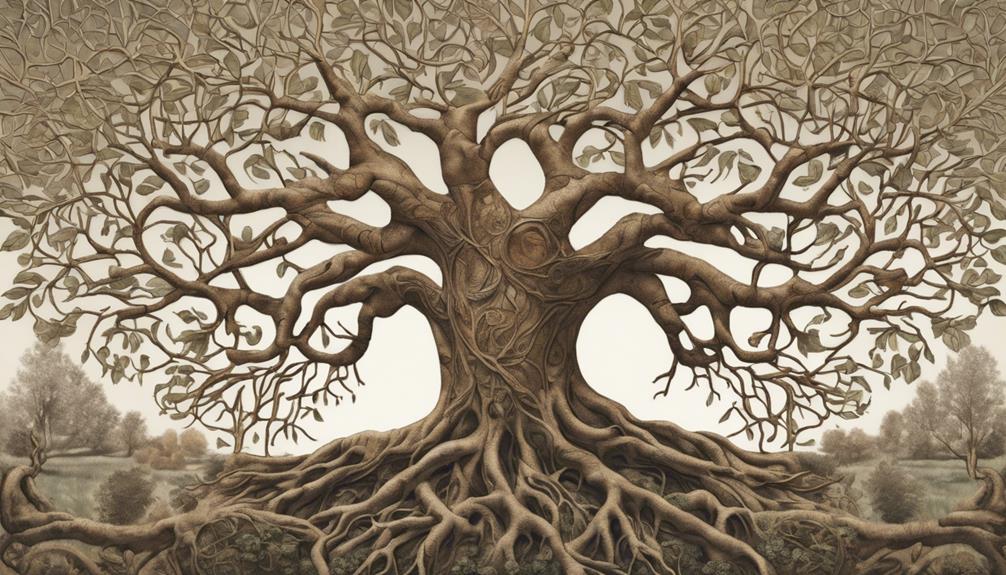
We understand that delving into your family tree can seem daunting, especially with the vast amount of information out there. However, searching through your ancestry can reveal fascinating discoveries that connect you to your roots in unexpected ways.
From uncovering long-lost relatives to understanding the cultural heritage that shaped your family, exploring your genealogy can provide a sense of identity and belonging that transcends generations. So, why not take the first step and embark on this journey of self-discovery through your family tree research?
Key Takeaways
- Gather vital info systematically from family for comprehensive family tree.
- Utilize essential records like death certificates, census for detailed genealogy.
- Explore census, city directories for family insights, movements, connections.
- Connect with genealogical societies for networking, resources, preservation efforts.
Starting Your Family Tree Research
To embark on your journey of family genealogy research, we must first delve into the foundational steps of starting your family tree research. Begin by gathering vital information about yourself, your parents, and grandparents. Record and organize details about your ancestors systematically to lay a strong groundwork for your family tree. Key elements such as names, dates, places, and relationships are crucial in identifying individuals in historical records. Understanding the significance of names, event dates, locations, and family connections is essential for constructing an accurate family tree.
Home resources like family documents, bibles, certificates, diaries, and photographs are invaluable for gathering essential data. These personal items can provide valuable insights and details that may not be available in public records. Utilizing these resources can uncover hidden gems of information about your ancestors that can enrich your family history research. Remember, by starting with what you know and gradually working backward, you can piece together a comprehensive picture of your family's lineage.
Essential Records for Genealogy
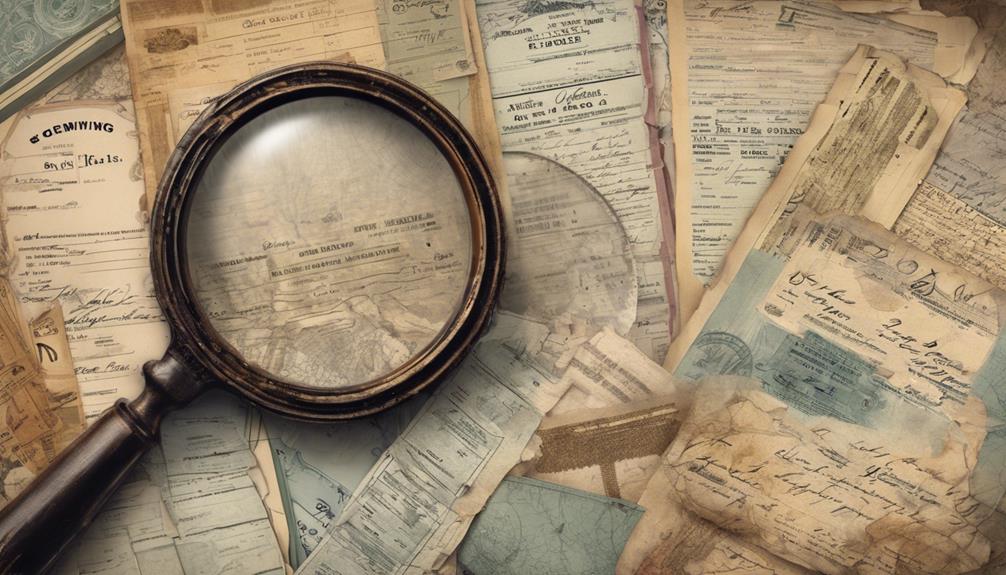
Embarking on our exploration of family genealogy research, we now turn our focus to the critical foundation provided by essential records for tracing and documenting our lineage. These essential records serve as the backbone of our family tree, offering invaluable insights into our ancestors' lives. Here are three key types of records crucial for genealogical research:
- Death Certificates: Death certificates provide vital information such as the date and cause of death, which can lead to discovering burial locations, next of kin, and sometimes even birthplaces.
- Federal Census Records: Census records are a treasure trove of details, offering a snapshot of our ancestors' lives every ten years, including names, ages, occupations, relationships, and addresses.
- Land Records: Land records not only reveal property ownership but also provide clues about migration patterns, economic status, and community connections that can enrich our understanding of our family history.
Delving into archives for these essential records can uncover fascinating details and help piece together the puzzle of our lineage.
Exploring Census and City Directories
Exploring Census and City Directories reveals a wealth of historical data crucial for understanding our ancestors' lives and societal connections. Census records, archived in the National Archives, provide a detailed snapshot of our family members' lives every decade in the United States. These records offer insights into family structures, demographics, occupations, and residential locations, enabling genealogists to track changes over time.
City directories complement census records by showcasing residents' addresses, businesses, and occupations, painting a vivid picture of urban life and community dynamics. By utilizing both census records and city directories in genealogical research, we can piece together a comprehensive understanding of our ancestors' lives within the societal contexts of their time. These resources not only help us trace family members' movements and connections but also shed light on the broader historical landscape in which they lived, enriching our appreciation for the past.
Utilizing Libraries and Archives

Libraries and archives provide a treasure trove of compiled family histories and local records essential for in-depth genealogical research. When delving into your family history, consider the following key points:
- Access to Courthouse Records: Libraries and archives offer a wealth of courthouse records such as wills, probate documents, land records, and deeds. These original documents can unveil vital information about your ancestors' lives and possessions.
- City Directories: Make use of city directories available in libraries to discover details about your ancestors' residences, occupations, and even business endeavors. These directories can provide insights into the daily lives of your relatives.
- State Archives Resources: State archives often house a plethora of valuable records beyond vital statistics. By exploring these archives, you can uncover family stories, track movements through state census records, and access a variety of original documents crucial for expanding your family tree research.
Connecting With Genealogical Societies
Engaging with genealogical societies enhances research depth and fosters collaboration with seasoned experts in the field. By joining these societies, individuals gain access to valuable networking opportunities, educational materials, and exclusive resources for delving into their family history. Members can attend workshops, conferences, and events tailored to genealogy research, expanding their knowledge and honing their research skills. Genealogical societies also play a crucial role in preservation efforts, supporting digitization projects and promoting genealogical research for the benefit of future generations.
| Benefits of Connecting with Genealogical Societies | |
|---|---|
| Networking Opportunities | Gain connections with fellow researchers and experts |
| Educational Materials | Access exclusive resources and databases for research |
| Preservation Efforts | Support digitization projects and research promotion |
| Future Generations | Contribute to the preservation of family history for future genealogists |
Frequently Asked Questions
How Do I Research My Family Genealogy?
When researching our family genealogy, we start by gathering vital information about immediate family members. We record names, dates, and places for previous generations.
Online platforms like Ancestry.com and FamilySearch.org are valuable resources. Preserving and scanning family photos can provide genealogical insights.
It's important to keep detailed records of sources and cross-check information for accuracy. This thorough approach helps us uncover our family history effectively.
What Is Included in Genealogy?
When exploring genealogy, one discovers a rich tapestry of family history woven through generations. Births, marriages, deaths, and occupations of our ancestors are meticulously documented.
Unraveling family connections and migrations reveals a captivating narrative of our past. Cultural heritage, traditions, and customs passed down offer insight into our roots.
Through genealogy, we gain a profound understanding of our heritage, connecting us to the stories of those who came before us.
How Can I Find My Genealogy for Free?
To find your genealogy for free, we recommend utilizing online platforms like FamilySearch.org and Ancestry.com. These sites offer valuable resources and databases. Additionally, USGenWeb.org and FindAGrave.com provide free options for research. Stay cautious of document accuracy on such sites.
Take advantage of free access during holidays and explore various platforms regardless of religious affiliation. Access to research databases is widely available online.
How to Pass on Research What to Include in Your Genealogy Will?
When passing on research in our genealogy will, we include vital documents, family narratives, and contact info for key resources. This ensures future generations can continue our work.
Organizing materials in a clear and accessible manner is crucial. Preservation of our research findings aids in maintaining our family's history.
Conclusion
In conclusion, delving into our family genealogy is like unraveling a complex tapestry of interconnected stories and relationships. By piecing together vital records, exploring historical documents, and connecting with genealogical societies, we gain a deeper understanding of our lineage and heritage.
Just as a skilled historian uncovers hidden truths in ancient manuscripts, we too can uncover the rich history of our ancestors through diligent research and exploration.
Albert brings a wealth of knowledge and expertise to our writing team. With a background in caregiving and a deep understanding of the challenges faced by caregivers, Albert’s writing resonates with authenticity and empathy. He is committed to delivering high-quality content that empowers and supports caregivers on their journey.
Activities
Taking a Trip Down Memory Lane: Crafting a DVD for Your Loved One With Dementia
Embark on a nostalgic journey like no other by crafting a DVD for your loved one with dementia – a heartfelt gesture that bridges past and present, igniting precious memories and emotions.
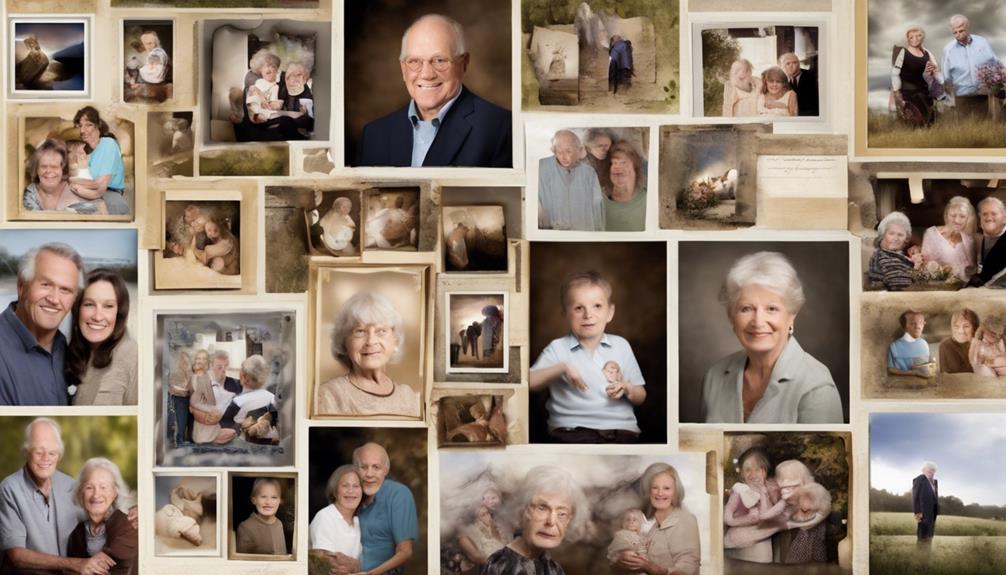
Making a DVD for a loved one affected by dementia could serve as the most significant way to encapsulate an entire lifetime’s worth of memories into a single, tangible object.
As we dive into the intricacies of selecting the perfect photos and songs, you'll discover how this personalized journey down memory lane can bridge the gap between past and present, igniting moments of recognition and joy.
Stay tuned to unravel the secrets of creating a heartfelt DVD that not only preserves cherished moments but also fosters a deeper connection with your loved one, sparking conversations and evoking emotions that transcend time.
Key Takeaways
- Nostalgia therapy benefits Alzheimer's and dementia patients.
- Create a cozy, distraction-free space for viewing.
- Select content that reflects cherished memories.
- Engage in activities triggering memories for comfort and connection.
The Power of Nostalgia
When creating a DVD for a loved one with dementia, tapping into the power of nostalgia can evoke cherished memories and emotions, providing comfort and connection. Memories from the past hold a special place in our hearts, and for individuals with dementia, these memories can be a source of joy and familiarity. Engaging in activities that trigger these memories can help bridge the gap between the past and the present, allowing your loved one to reminisce about happier times.
Dementia can often make it challenging for individuals to recall recent events, but memories from years gone by tend to remain intact. By incorporating old pictures, music, and storytelling into the DVD, you can create a treasure trove of nostalgia that brings comfort and happiness to your loved one. Nostalgia therapy has shown remarkable benefits for Alzheimer's and dementia patients, helping them feel more at ease and connected to their identity. So, as you craft this DVD, remember the power of nostalgia in unlocking precious memories and emotions for your loved one.
Step-by-Step Guide

As we embark on the journey of creating a memory DVD for a loved one with dementia, our first crucial step is gathering photographs and videos to capture cherished moments and create a meaningful experience. This process can be emotional, so remember to take breaks and care for yourself throughout.
Here are some tips to guide you through this journey:
- Handle Memories with Care: Treat each photograph and video clip as a precious memory, honoring the stories they hold.
- Embrace Emotions: Allow yourself to feel the nostalgia and love that come with revisiting these moments.
- Create a Safe Space: Set up a cozy, quiet area where you can immerse yourself in the memories without distractions.
- Celebrate Every Moment: Recognize the importance of this activity in connecting with your loved one and creating lasting memories.
Each step you take in this process is a meaningful activity, not just for your loved one but also for you. Embrace the journey down memory lane with compassion and dedication.
Choosing the Right Content
To curate a memory DVD that resonates deeply with your loved one with dementia, carefully selecting photos and videos that hold significant sentimental value is essential. When choosing the right content, focus on incorporating images and videos that reflect past events and cherished memories shared with loved ones. These visuals can serve as powerful triggers, taking your loved one on a heartfelt journey back in time. Including moments from family gatherings, special occasions, and vacations can evoke a sense of nostalgia and connection to their past.
Additionally, integrating music that's meaningful to your loved one can enhance the emotional impact of the DVD. Songs that resonate with their past experiences and emotions can help create a comforting and familiar atmosphere. Organize the content in a coherent manner, either chronologically or thematically, to weave a compelling narrative that guides them through the journey of 'Taking a Trip' down memory lane. By carefully selecting content that's engaging, positive, and tailored to their preferences, you can ensure a truly meaningful viewing experience for your loved one.
Personalizing the DVD
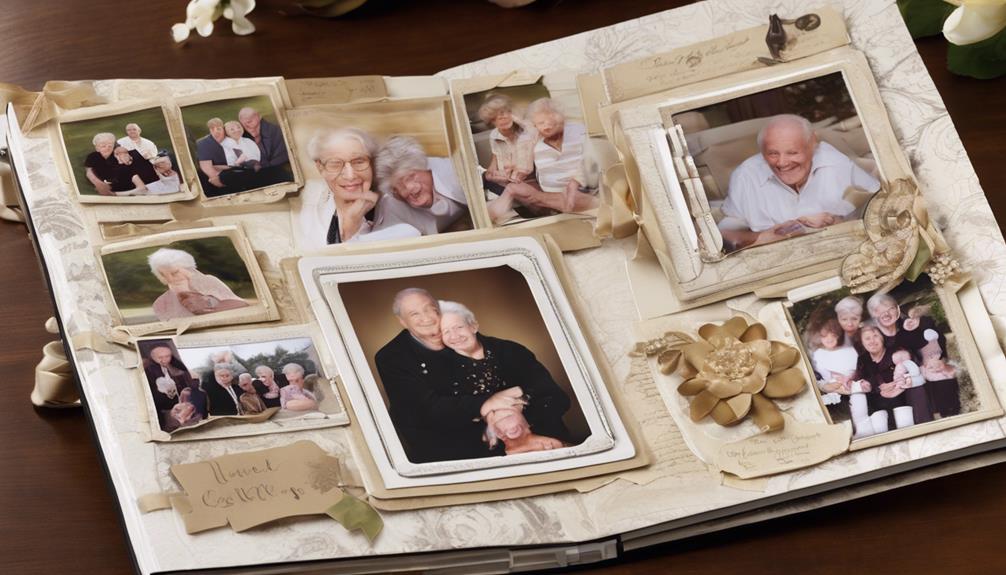
Let's now focus on personalizing the DVD to create a truly meaningful and engaging experience for your loved one living with dementia. When crafting the DVD for your loved one's journey down memory lane, consider these emotional touches:
- Selecting photos and videos that hold special memories can bring a sense of familiarity and comfort.
- Incorporating their favorite music won't only enhance the viewing experience but also help evoke cherished memories.
- Adding recorded messages or voiceovers can establish a personal connection and convey love and warmth.
- Organizing the content chronologically or by themes can help create a cohesive narrative that resonates with your loved one.
Editing and Finalizing
When finalizing the DVD for your loved one with dementia, ensure that the transitions, music, and effects are thoughtfully added to enhance their viewing experience. These elements can help create a seamless and engaging journey through the memories captured on the DVD. It's crucial to keep in mind that individuals living with Alzheimer's may have varying levels of cognitive abilities, so simplicity and clarity in editing are key.
As family members, we've the opportunity to create a personalized and meaningful viewing experience for our loved ones. By carefully arranging photos and videos in a coherent manner, we can help them follow along and connect with the content on a deeper level. Adding personalized touches like captions or recorded messages can also make the DVD more engaging and emotionally resonant.
Before finalizing the DVD, it's essential to double-check for any errors or inconsistencies. Ensuring that the menu is easy to navigate will make the viewing experience more enjoyable for your loved one. By putting in this extra effort during the editing and finalizing process, we can create a special keepsake that brings joy and comfort to our family member with dementia.
Frequently Asked Questions
How Can I Ensure That the DVD Will Be Easy for My Loved One With Dementia to Navigate and Use?
To ensure the DVD is easy for our loved one with dementia to use, let's keep it simple.
We should organize it into clear sections with large, easy-to-read labels. Using familiar pictures or symbols can also help them navigate.
Including familiar music or voices can provide comfort and aid in recognition.
Lastly, we can test the DVD with our loved one to make sure it's user-friendly and enjoyable for them to use.
Are There Any Copyright Issues I Need to Be Aware of When Selecting Content for the Dvd?
Absolutely, it's crucial to consider copyright issues when selecting content for the DVD. We must be mindful of using only materials that we've the rights to, to avoid any legal complications.
It's essential to prioritize the well-being of our loved one and ensure that the process of creating the DVD is done ethically and respectfully. Let's make sure we gather content that brings joy and comfort without infringing on any copyrights.
What Are Some Tips for Creating a Calming and Comforting Viewing Experience for My Loved One With Dementia?
Creating a calming and comforting viewing experience for our loved one with dementia involves selecting familiar, soothing content. Keep lighting soft, minimize background noise, and offer gentle reassurances throughout.
Incorporate favorite music or nature scenes to evoke positive emotions. Ensure the environment is cozy and free of distractions. Watching together can also provide a sense of security and connection.
These small adjustments can make a big difference in their overall well-being and enjoyment.
How Can I Involve Other Family Members in the Process of Creating the Dvd?
We can involve other family members in creating the DVD by assigning different tasks based on their strengths and interests. Some can gather photos, others can write heartfelt messages, and a few can help with editing. By sharing the workload, we ensure everyone contributes in a meaningful way.
Encouraging open communication and collaboration allows us to create a personalized and touching DVD that truly reflects our loved one's life and journey.
Are There Any Special Considerations I Need to Keep in Mind When Presenting the DVD to My Loved One With Dementia for the First Time?
When presenting the DVD to our loved one with dementia for the first time, we should create a calm and familiar environment.
It's important to be patient, allowing them time to process the information. Using gentle reminders about who's in the video and the memories shared can help orient them.
Keep the viewing session short to prevent overwhelming them. Remember, the goal is to bring joy and connection through the shared memories.
Conclusion
In conclusion, crafting a DVD for a loved one with dementia is a meaningful way to share memories and create moments of connection. By taking a trip down memory lane together, we can evoke emotions, spark recognition, and strengthen bonds that transcend time.
So why not take the time to preserve precious memories and create a lasting keepsake that will bring comfort and joy for years to come?
Albert brings a wealth of knowledge and expertise to our writing team. With a background in caregiving and a deep understanding of the challenges faced by caregivers, Albert’s writing resonates with authenticity and empathy. He is committed to delivering high-quality content that empowers and supports caregivers on their journey.
Activities
Art Lesson Plans May Ward Off Memory Problems
Hesitate no more – discover how art lesson plans could be the key to preserving memory and cognitive function.

As we explore the intriguing realm of mental health and creative endeavors, have you ever considered what impact incorporating art lessons into our daily routines could potentially have?
The link between engaging in creative activities and fending off memory problems among older adults is a topic worth contemplating.
Let's delve into how art lessons could offer a promising avenue for nurturing cognitive function and potentially safeguarding against memory decline.
Key Takeaways
- Art lessons nurture creativity and safeguard memory function.
- Regular art activities reduce the likelihood of memory issues.
- Engaging in art lowers the risk of cognitive impairment.
- Art therapy techniques forge new neural connections for memory enhancement.
Benefits of Engaging in Art Lessons
Engaging in art lessons offers a transformative journey that not only nurtures creativity but also serves as a powerful tool in safeguarding memory function as we age. Art therapy and engaging in crafts activities have been linked to a reduced risk of cognitive decline in older adults. Studies have shown that participation in art activities such as painting, drawing, woodworking, quilting, and sewing can help delay the development of memory problems, including dementia.
Creative arts, including these crafts activities, have been found to have a significant impact on cognitive health, with individuals who regularly partake in these activities experiencing a lower likelihood of memory issues. By immersing ourselves in the world of art, we not only express our creativity but also potentially protect our cognitive abilities as we grow older. This journey through art can be a fulfilling way to stimulate our minds and enhance our overall well-being.
Impact of Art on Memory Function
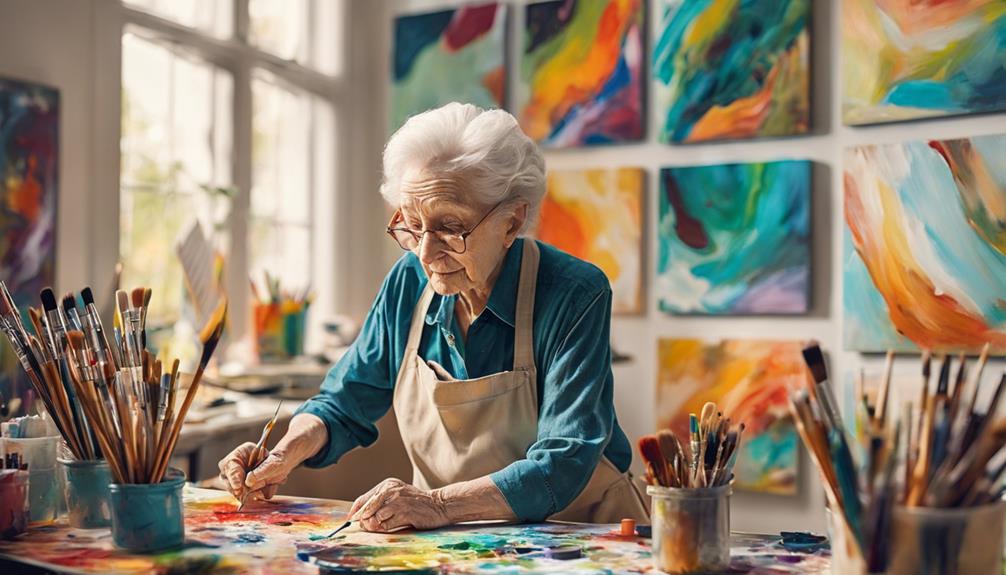
Exploring the profound relationship between art and memory function reveals a captivating journey through the realms of creativity and cognitive preservation. Engaging in art, such as painting or woodworking, can play a crucial role in reducing the risk of memory problems, including cognitive impairment in old age. A study focusing on individuals aged 85-89 discovered that participation in arts and crafts significantly decreased the likelihood of developing mild cognitive impairment. Men and women who practiced crafts like quilting and sewing were found to have a 45% lower risk of memory issues. Additionally, social activities have been shown to lower the risk by 55%, highlighting the importance of social engagement in memory health. Furthermore, computer use, particularly activities like Internet searches, was linked to a 53% decrease in the risk of mild cognitive impairment. Art, whether through creative expression or engaging in social activities, can be a powerful tool in preserving memory function and reducing the risk of conditions like Alzheimer's disease.
| Art Activities | Impact on Memory Function |
|---|---|
| Painting | Reduces risk of memory issues |
| Woodworking | Helps ward off cognitive impairment |
| Quilting & Sewing | 45% lower likelihood of memory problems |
| Social Activities | 55% lower risk of memory issues |
Connection Between Art and Cognitive Health
Artistic endeavors, such as painting and woodworking, offer a gateway to enhancing cognitive health and fostering memory resilience in individuals of all ages. Engaging in artistic activities not only stimulates creativity but also plays a crucial role in maintaining cognitive functions. For older adults, participating in art projects can significantly lower the risk of memory problems and mild cognitive impairment. The act of creating art provides a mental workout that can help preserve memory and cognitive abilities over time.
Moreover, the social aspect of artistic endeavors further contributes to cognitive health. Studies show that social engagement can reduce the likelihood of memory issues by 55%, emphasizing the importance of interaction in maintaining cognitive functions. Additionally, activities like computer use, such as browsing the internet, have been linked to a 53% lower risk of mild cognitive impairment, highlighting the various ways in which technology and art can positively impact cognitive health. Embracing artistic activities not only enriches life but also serves as a form of memory care, potentially warding off conditions like dementia.
Strategies for Implementing Art Lesson Plans
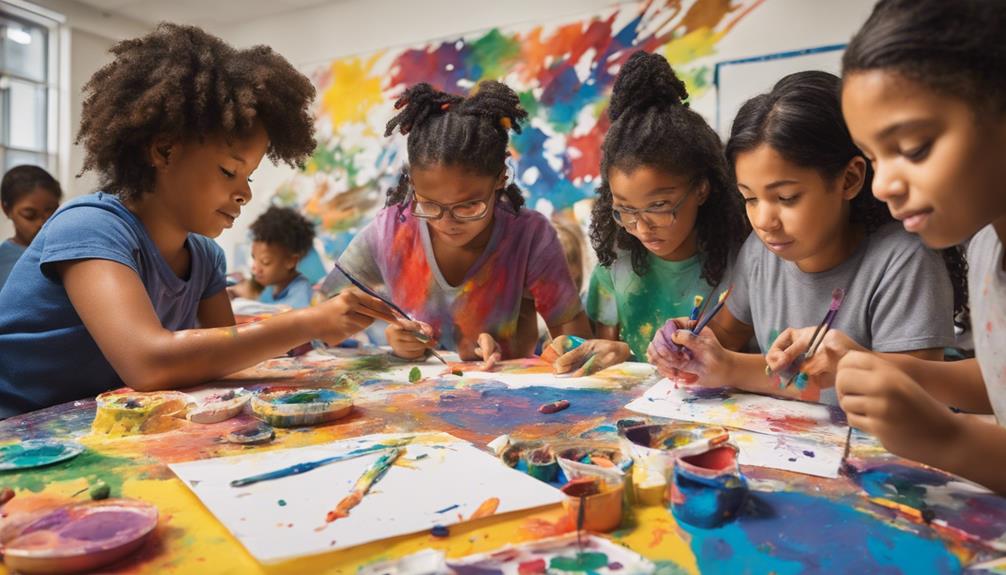
Connecting seniors with the joy of artistic expression through carefully crafted lesson plans is a pivotal step towards enhancing cognitive health and memory retention. When implementing art lesson plans for older adults, it's essential to offer a diverse range of activities such as painting, drawing, sculpting, woodworking, ceramics, quilting, and sewing. By providing a variety of artistic outlets, seniors can engage in activities that cater to different interests and skill levels, ensuring a more inclusive experience.
Incorporating social engagement into art projects is key to reducing the risk of memory problems in seniors. Encouraging group activities where individuals can interact, share ideas, and collaborate on creative endeavors not only fosters a sense of community but also stimulates cognitive function. Moreover, utilizing computer technology for activities like online shopping and internet searches can further lower the likelihood of mild cognitive impairment, offering seniors a chance to stay technologically savvy while enhancing their mental acuity through artistic expression.
Art Therapy Techniques for Memory Enhancement
Enhancing memory through art therapy techniques involves harnessing the power of creative expression to forge new neural connections in the brain, supporting cognitive function and memory retention. Engaging in art activities like painting and drawing stimulates these neural connections, aiding in memory enhancement. Art therapy focuses on using creative expression to trigger positive memories and emotions, which can be particularly beneficial for individuals facing memory problems. By creating new connections in the brain through artistic endeavors, individuals can bolster their cognitive abilities and improve memory retention.
Studies have shown that art therapy is an effective tool in enhancing memory and cognitive function. Through the process of creating art, individuals can tap into different parts of their brain, fostering a holistic approach to memory enhancement. By incorporating art therapy techniques into memory improvement strategies, individuals can't only stimulate their minds but also enjoy the therapeutic benefits of creative expression.
Frequently Asked Questions
How Does Art Help With Memory Loss?
Art helps with memory loss by stimulating the brain through creative expression. Engaging in art activities like painting and crafting forms new connections in the brain, reducing the risk of memory problems. Art projects strengthen cognitive functioning and can even prevent Alzheimer's disease.
Through artistic expression, individuals can communicate and express themselves, fostering positive emotions and triggering new memories. Art therapy provides a non-verbal outlet for those with memory loss to connect and engage with the world.
Does Making Art Prevent Dementia?
Making art can be a powerful tool in preventing dementia. Engaging in artistic activities like painting, drawing, and woodworking can lower the risk of developing mild cognitive impairment.
Studies have shown a significant decrease in memory problems for individuals who participate in arts and crafts. Additionally, creating art fosters cognitive stimulation and social engagement, both essential components in maintaining brain health and potentially warding off dementia.
How to Prevent Memory Loss?
To prevent memory loss, we prioritize engaging in activities that challenge our minds, such as learning new skills, puzzles, and physical exercise.
Additionally, maintaining social connections and staying mentally active through hobbies like painting, drawing, or crafts can also help stave off cognitive decline.
How Do You Help Someone With Poor Memory?
When someone struggles with poor memory, we can offer support through various means. Encouraging daily routines, like consistent sleep and exercise, can help.
Creating memory aids, such as notes or reminders, is beneficial. Engaging in social activities and conversations can also stimulate memory.
Additionally, incorporating puzzles and games into their routine can be fun and helpful. By combining these strategies, we can provide holistic support for those facing memory challenges.
Conclusion
In the palette of life, art lesson plans add vibrant colors to our memories, painting a picture of cognitive vitality and creativity. Like skilled artists, we brush away the dust of forgetfulness with each stroke of a paintbrush or twist of a clay mold.
Let's continue to sculpt our minds with the beauty of art, preserving our memories like precious masterpieces on the canvas of our lives.
Albert brings a wealth of knowledge and expertise to our writing team. With a background in caregiving and a deep understanding of the challenges faced by caregivers, Albert’s writing resonates with authenticity and empathy. He is committed to delivering high-quality content that empowers and supports caregivers on their journey.
-

 Dementia Care2 weeks ago
Dementia Care2 weeks agoHow Gabapentin Affects Dementia: A Comprehensive Guide
-

 Dementia Care2 months ago
Dementia Care2 months agoUnderstanding the Stages of Vascular Dementia: A Visual Chart Guide
-
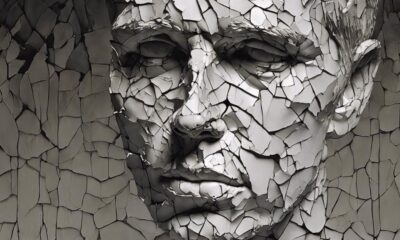
 Dementia Care2 weeks ago
Dementia Care2 weeks ago5 Things You Need to Know About Jack Nicholson’s Dementia
-

 Medication Management1 month ago
Medication Management1 month agoGabapentin Side Effects: Memory Loss Concerns?
-
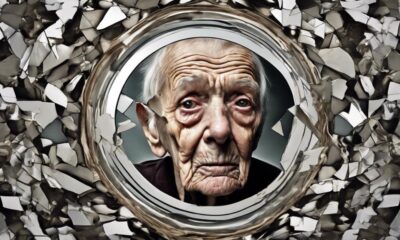
 Dementia Care2 months ago
Dementia Care2 months agoUnderstanding Narcissism and Dementia: A How-To Guide
-

 Palliative Care for Parkinson's2 weeks ago
Palliative Care for Parkinson's2 weeks agoPalliative Care for Parkinson’s: A New Hope for Patients”
-
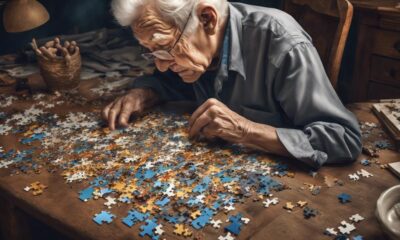
 Dementia Care2 weeks ago
Dementia Care2 weeks ago10 Engaging Dementia Games for Cognitive Stimulation
-
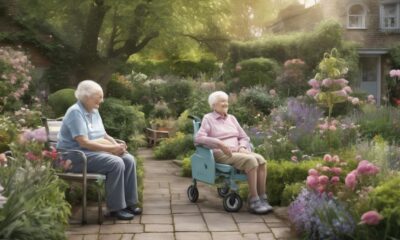
 Dementia Care2 months ago
Dementia Care2 months agoHow to Deal with a Parent’s Dementia: A Practical Guide

















